|
|
|
Sort Order |
|
|
|
Items / Page
|
|
|
|
|
|
|
| Srl | Item |
| 1 |
ID:
120094
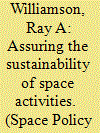

|
|
|
|
|
| Publication |
2012.
|
| Summary/Abstract |
The growth of new space systems and the continued creation of orbital debris could in a few years make activities in Earth orbit unsustainable, so finding cost-effective ways to sustain space activities in Earth orbit is essential. Because outer space activities serve the needs of the military-intelligence, civil, and commercial communities, each with their own requirements, creating the necessary international agreements for reaching and maintaining a condition of sustainability will not be easy. This paper summarizes the primary issues for the international space community regarding our future ability to reap the benefit of space systems in Earth orbit. It explores several of the efforts to develop international agreements that would lead to or support the sustainability of space activities and examines the benefits and drawbacks of each approach. In particular, it reviews progress within the UN COPUOS, and examines the EU's proposal for an international Code of Conduct for Outer Space Activities. It also notes the need for states to establish or expand their own space legal infrastructure to conform to the UN treaties and guidelines for space activities.
|
|
|
|
|
|
|
|
|
|
|
|
|
|
|
|
| 2 |
ID:
120098


|
|
|
|
|
| Publication |
2012.
|
| Summary/Abstract |
Space sustainability is emerging as a core element of national policy and international initiatives. At this time, however, a coherent strategy and supporting policies have not been developed. To initiate a conversation to develop such a strategy, the authors have applied the principles developed by Elinor Ostrom for terrestrial common-pool resource (CPR) governance to near-Earth orbit in space. A concern arises as to whether Ostrom's eight principles are a good "fit" for application to space CPR because of the unique physical characteristics of space and the legal underpinnings of our presence there. This commentary will address selected issues raised by Weeden and Chow, and suggest alternative ways to approach near-Earth orbit sustainability.
|
|
|
|
|
|
|
|
|
|
|
|
|
|
|
|
| 3 |
ID:
120102


|
|
|
|
|
| Publication |
2012.
|
| Summary/Abstract |
The history of the satellite insurance market indicates that this market experiences crises and booms in profitability and prices that repeat in a manner suggestive of cycles. The purpose of this article is to rigorously investigate cyclicality of these and other features of the satellite insurance market and assess their volatility formally. Using data from 1968 to 2008, volatility and cyclicality are analyzed for satellite insurance market capacity, rates, and underwriting results, among other measures. The coefficient of variation for the various satellite insurance market metrics is used to assess volatility. Standard underwriting analysis is used to determine whether a cycle exists for various insurance metrics. The results indicate that some aspects of the satellite insurance market are volatile (e.g. claims) or cyclical (e.g. rates), while capacity is both volatile and cyclical.
|
|
|
|
|
|
|
|
|
|
|
|
|
|
|
|
| 4 |
ID:
120101
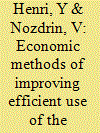

|
|
|
|
|
| Publication |
2012.
|
| Summary/Abstract |
Satellite systems continue to play an important role in the booming market for communication and broadcasting services, driving up demand for use of the orbit/spectrum resource. Studies are required to address the problem of orbit capacity and find ways of making more efficient use of it, to avoid a situation in which there is not enough orbit/spectrum resource to cater for the development of future satellite networks. It is argued that, as far as satellite networks are concerned, the current international regulatory regime governing the use of the spectrum has significant shortcomings, which have a cost, in terms of resources and time, and make investment in satellite projects less attractive. An approach is proposed for improving efficiency of the use of the orbit/spectrum through the introduction of economic methods, to supplement the existing technical and regulatory regime. A spectrum pricing method is proposed for satellite communication systems.
|
|
|
|
|
|
|
|
|
|
|
|
|
|
|
|
| 5 |
ID:
120091
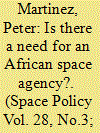

|
|
|
|
|
| Publication |
2012.
|
| Summary/Abstract |
Over the past few years, the view has been expressed in some quarters that Africa should establish a continental space agency. Various arguments are advanced for this, but they are generally not compelling and rely mostly on pointing to the existence of other regional space cooperation organisations, or to benefits that are debatable. The article considers these arguments and concludes that there is an insufficient case for the establishment of an African space agency at this point in the development of the space arena in Africa. Instead, greater emphasis should be placed on strengthening nascent national space programmes, fostering intra-regional cooperation and raising the profile of space activities in Africa's national and regional political structures.
|
|
|
|
|
|
|
|
|
|
|
|
|
|
|
|
| 6 |
ID:
120095


|
|
|
|
|
| Publication |
2012.
|
| Summary/Abstract |
The success of space-based systems worldwide, providing services to society and satisfying defence and security needs, has led to a situation where outer space is increasingly crowded. In addition, the rapid proliferation of space debris threatens the safe utilization of outer space on the most commonly used orbits. Beyond the mitigation of the orbital debris threat, additional measures will be needed to ensure the safety and security of activities in outer space for the long-term. This article describes the initiative to introduce a new agenda item in the United Nations Committee on the Peaceful Uses of Outer Space (COPUOS), first presented to COPUOS delegations in 2007, which led to a formal decision in 2009. This in turn led to the establishment of a dedicated Working Group of the Scientific and Technical Sub-Committee in 2010, with a work plan leading to a report and associated recommendations in 2014. Some references are made to other initiatives affecting space security, such as the Russia-China draft treaty (PPWT) tabled at the Conference on Disarmament and the EU-proposed Code of Conduct.
|
|
|
|
|
|
|
|
|
|
|
|
|
|
|
|
| 7 |
ID:
120093


|
|
|
|
|
| Publication |
2012.
|
| Summary/Abstract |
This paper surveys recent and current advancements of laser-induced ablation technology for space-based applications and discusses ways of bringing such applications to fruition. Laser ablation is achieved by illuminating a given material with a laser light source. The high surface power densities provided by the laser enable the illuminated material to sublimate and ablate. Possible applications include the deflection of Near Earth Objects - asteroids and comets - from an Earth-impacting event, the vaporisation of space structures and debris, the mineral and material extraction of asteroids and/or as an energy source for future propulsion systems. This paper will discuss each application and the technological advancements that are required to make laser-induced ablation a practical process for use within the space arena. Particular improvements include the efficiency of high power lasers, the collimation of the laser beam (including beam quality) and the power conversion process. These key technological improvements are seen as strategic and merit greater political and commercial support.
|
|
|
|
|
|
|
|
|
|
|
|
|
|
|
|
| 8 |
ID:
120100
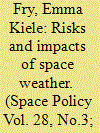

|
|
|
|
|
| Publication |
2012.
|
| Summary/Abstract |
Space weather affects global technological systems and societies. Space weather, or the dynamic conditions on the Sun and in the space environment and their impacts on technological systems, can produce coronal mass ejections, solar energetic particles, and geomagnetic disturbances. These space weather events can cause extreme currents in the electric grid, widespread blackouts, and phone and internet communication failures both in space and within the Earth's atmosphere. Severe space weather can damage satellites used for global positioning, communications, and weather forecasting. It also creates a risk of radiation exposure to astronauts and commercial airline crews and passengers. Accurate forecast knowledge of the space weather threat and timing of events is critical to planning and preparation to minimize socioeconomic impacts. This paper reviews the scope of the space weather threat on the global community today. It describes current international and US public policy initiatives to mitigate risk to infrastructure, public safety, and human life. It examines recent international reports and US federal disaster reduction plans to meet these challenges and provides recommendations to increase public awareness and implement public policies to prepare, prevent, and recover from possible catastrophic failures of commercial and government infrastructures caused by a major space weather event.
|
|
|
|
|
|
|
|
|
|
|
|
|
|
|
|
| 9 |
ID:
120097


|
|
|
|
|
| Publication |
2012.
|
| Summary/Abstract |
This paper examines Nobel Prize Winner Elinor Ostrom's principles for sustainable governance of common-pool resources (CPR), capturing the best practices of CPRs over the years, which avoid the "Tragedy of the Commons" without being either completely privatized or controlled by a Leviathan entity. Ostrom's principles highlight, inter alia, the need for clear boundary definitions, rules tailored to fit the domain, who has a say in formulation of collective-choice agreements and operational rules, monitoring of behavior, graduated penalties, and conflict resolution mechanisms. In the context of the space domain they highlight issues such as the definition of where space begins, gaps in the existing liability regime, the concept of collaborative space situational awareness, and how best to include emerging and developing space actors in negotiations and decision making. The paper concludes that Ostrom's principles highlight specific areas on which to focus initial space sustainability efforts and national and international policy. It also recommends further analysis into how best to translate her principles to the space domain, where they may not be wholly applicable because of the unique nature of space, and how to evolve space governance institutions and mechanisms to best suit the unique environment of outer space.
|
|
|
|
|
|
|
|
|
|
|
|
|
|
|
|
| 10 |
ID:
120092


|
|
|
|
|
| Publication |
2012.
|
| Summary/Abstract |
UNCOPUOS recently celebrated its 50th anniversary and has a range of achievements to show for it. But it is now very different - in both type and number of members - from the organization established at the start of the Cold War and needs to consider its future direction. An obvious topic to pursue is the long-term sustainability (LTS) of space activities, which, after some false starts, has now been adopted. One Working, and Four Expert, Groups have been set up to examine different aspects of the subject, though care must be taken to ensure that these are properly integrated into a multidisciplinary framework. Despite valid objections that LTS could be used to deny access to space to latecomers to the club, it is important to proceed with LTS while taking account of delegations' concerns.
|
|
|
|
|
|
|
|
|
|
|
|
|
|
|
|
| 11 |
ID:
120099
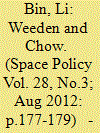

|
|
|
|
|
| Publication |
2012.
|
| Summary/Abstract |
The paper, 'Space sustainability through the sustainable management of common-pool resources: a framework and potential policies' by Brian Weeden and Tiffany Chow, researches Long-Term Sustainability issues (LTS) from the perspectives of both economics and governance, focusing on analyzing Elinor Ostrom's principles, and puts forward the main elements for a management regime. Their paper will be helpful for the international community to understand the importance of LTS, to further discussions in this field and even to shape a framework for tackling LTS. On the other hand, some of the principles raised by Ostrom still need to be clarified and deliberated throughout the international community. This commentary will analyze some of Ostrom's principles from the perspective of the 1967 Outer Space Treaty (OST) and put forward the values LTS should encompass based on an analysis of its relations with provisions in the OST.
|
|
|
|
|
|
|
|
|
|
|
|
|
|
|
|
|
|
|
|
|